金沙遗址博物馆英文介绍
- 格式:doc
- 大小:5.57 KB
- 文档页数:2

金沙遗址英语作文素材The Jinsha Site is an important archaeological discovery in China, located in Chengdu, Sichuan Province. It dates back to the Shang and Zhou dynasties and has provided a wealth of information about the ancient Shu civilization. Excavations at the site have uncovered numerous artifacts, including bronze objects, jade ornaments, and elephant tusks, as well as the remains of buildings and sacrificial pits.The discovery of the Jinsha Site has greatly enhanced our understanding of the ancient Shu culture. The artifacts found at the site have revealed the advanced craftsmanship and artistic skills of the Shu people. The intricate designs and exquisite workmanship of the bronze objects and jade ornaments indicate a high level of technological and artistic achievement. The discovery of elephant tusks at the site suggests that the Shu people had trade and communication networks with distant regions.The layout of the Jinsha Site also provides valuable insights into the social and religious practices of the ancient Shu people. The remains of large buildings andsacrificial pits indicate that the site was a center for religious and ceremonial activities. The discovery of various ritual objects and human sacrifices at the site has shed light on the religious beliefs and rituals of the Shu people. The presence of large quantities of gold and other precious materials at the site suggests that the Shu civilization was prosperous and had a well-developed economy.Overall, the Jinsha Site is a significant archaeological discovery that has greatly enriched our knowledge of the ancient Shu civilization. The artifacts and remains found at the site have provided valuable evidence of the advanced technological, artistic, and religious achievements of the Shu people.金沙遗址是中国的重要考古发现之一,位于四川省成都市。
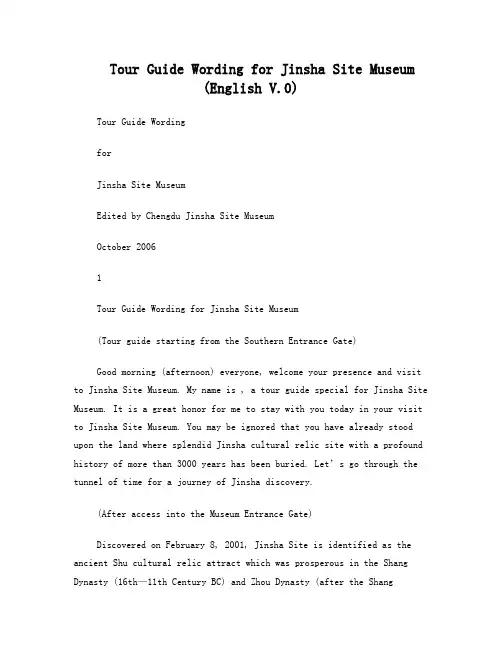
Tour Guide Wording for Jinsha Site Museum(English V.0)Tour Guide WordingforJinsha Site MuseumEdited by Chengdu Jinsha Site MuseumOctober 20061Tour Guide Wording for Jinsha Site Museum(Tour guide starting from the Southern Entrance Gate)Good morning (afternoon) everyone, welcome your presence and visit to Jinsha Site Museum. My name is , a tour guide special for Jinsha Site Museum. It is a great honor for me to stay with you today in your visit to Jinsha Site Museum. You may be ignored that you have already stood upon the land where splendid Jinsha cultural relic site with a profound history of more than 3000 years has been buried. Let’s go through the tunnel of time for a journey of Jinsha discovery.(After access into the Museum Entrance Gate)Discovered on February 8, 2001, Jinsha Site is identified as the ancient Shu cultural relic attract which was prosperous in the Shang Dynasty (16th—11th Century BC) and Zhou Dynasty (after the ShangDynasty to 221 BC). Jinsha Site is situated in the northwest of Chengdu City, between the 2nd Ring Road and the 3rd Ring Road, 5 kilometers away from Chengdu City Center the Tianfu Square. Jinsha Site was discovered by accident in a capital construction site which was on progress. This discove ry was awarded as ―2001 China Top Ten Archaeological Dis coveries‖ in the same year when it was unearthed. Through years’ archaeological study and excavation, it is quite certain that the site distribution is scattered over 5 square kilometers around. Within this historical cultural site, some important cultural heritages such as large-scale palace-style buildings, sites for worship activities,civilian housing area and Graves have been discovered. About over 6000 pieces of precious cultural relics including gold wares, bronze wares, jade wares, stone wares, lacquered wooden wares along with a large number of ceramic wares, ivories, wild boar buckteeth and deer horns have been unearthed. These unearthed discoveries help us a lot in understanding in general the living style, production, custom for burying the death, religious worship of ancient Shu people in Jinsha Time; in addition, they are also helpful for us to draw an initial conclusion regarding the nature and age of the heritage site. Upon the evaluation of the scale of the Site and some high honorable traces and relics discovered in the Site, Jinsha Site can be conjectured once to be the Capital ofancient Shu State followed after San Xing Dui Civilization fromlate Shang Dynasty to the Western Zhou Dynasty.Jinsha Site is recognized as the most important archaeological discovery of China in early 21st Century as well as another significant archaeological discovery followed after San Xing Dui discovery inSichuan Province. Discovery of Jinsha Site greatly extended the content of the ancient Shu culture, which is of great significance in research on the origin, development and decay and perish of the Shu culture; in particular, it provided us with reliable evidence to explain the miracle of sudden perish of San Xing Dui civilization. It is no doubt to advocate that Jinsha Site has reproduced the glory and prosperity of the ancient Shu State, recovered a missed history and revealed the 3000-year-long sleeping ancient civilization. Furthermore, this discovery has brought forward the history of Chengdu existence from 2300 years ago to about 3000 years ago.Like a thunder advocating the coming of spring, Jinsha Site started with a new page to look into the miracle of ancient Shu State. And also due to such discovery, Jinsha Village located in the northwest suburb of Chengdu City which was quite unknown by the public before year 2001 has become a magnetic field in West China attracting wide public concerns and peoples’ curiosity.(From the Entrance Gate to the Relics Site Hall)Jinsha Site had received wide concern from all works of the society when it was discovered. The State and CCP leaders have shown their special concerns and contributed their great efforts to the excavation, protection and construction of Jinsha Site. More than 20 top leaders from the China Central Government including Jiang Zemin, Zeng Qinghong, Wu Guanzheng, Qiao Shi, Song Ping, Wei Jianxing, Wang Lequan, Wu Yi, Li Lanqing, Li Tieying, Jiang Chunyun and Chen Zhili and so on have paid their visit and inspection one after anther to Jinsha Site, leavingtheir instructions to explore, protect and construct Jinsha Site well.Various governmental administration and departments of each level suchas State Administration of Cultural Heritage, Sichuan Provincial CCP Committee, Sichuan Provincial People’s Government, Chengdu Municipal CCP Committeeand Chengdu Municipal People’s Government also have contributed their high regard and support to the protection and construction of Jinsha Site. Early in the end of 2002, Chengdu Municipal CCP Committee and Pe ople’s Government specified the boundary for the site protection and zone under control of new construction, and set about to develop the general plan for the site cultural heritage protection and itsfeasibility study in 2003. In 2004, Jinsha Site Museum project was approved for construction. In 2006, construction of Jinsha Site Museum was entirely completed.Situated at the site where Jinsha cultural relics were unearthed, Jinsha Site Museum covers a floor area of 456 mu (equal to 300,000 m2), total construction area of approximately 35,000 m2, which consists of Relics Hall, Exhibition Hall, Cultural Heritage Conservation Center,Park Zone and other key sections with a total construction investment amounted up to RMB309 million (cost for land use excluded). The Park Zone facilitated for the Museum is eco-environmental oriented dedicated to the site heritage protection purpose through a large quantity ofevery-green plantation, such as phoebe nanmu, gingko and metasequoia etc. In order to prevent from any damage to the virgin earth, plantations of those trees are all rooted in the backfilled earth with a depth of 2m.The small path on our left site is called ―Road of Jade‖. Our ancient ancestors started their pioneering from this land full ofjungles and dangers where we are standing upon now to far-off high mountains to mine, select and transport jade stones piece by piece, leaving us a great number of fancy jade artworks to nowadays. Today, walking on this ―Road of Jade‖, I am hundred percent sure you are feeling and experiencing the hardship suffered by our ancestors inmining jade stones thousands years ago. On our right side, there stands the ―Ebony Forest‖, a window of antiquity and time-fading. Before Dujiangyan Irrigation System construction by Li Bing, Chengdu Plain was frequently struck by floods, which often resulted in river course change. When a flood occurred in the upper stream, various trees were flushedand buried deeply in the ancient river course, which remained not rotted though 3000~12000 years has been passed. Since such deeply buried trees appear deep black color from the surface to the inside,Sichuan people call them ebony wood. From a scientific point of view, these so-called ebony trees can be varied in tree species. Due to its unique features such as compact density, organic matter decomposition completion, no deformation and no worm birth, ebony woodis precious and expensive with a folksay like this ―Ten thousand L iang (Chinese ancient measurement unit equal to 50g) of gold deposit at house is not worth one cubic meter of ebony wood in the field‖. A large number of ebony wood has been discovered in Jinsha Site as well as area neighboring Chengdu Plain. This live ―fossil‖ fully proves that the ancient Chengdu Plain had sound eco-environment.(Permanent LOGO of Sun and Immortal Bird)The sculpture standing before us originates from the ―Sun and Immortal Bird‖ gold ornamental article unearthed in Jinsha Site. Theoutside diameter of the original piece is 12.5 cm. With its meaningful look and feel, precise structural composition, beautifully flowing patterns together with rich rhythm, it condensed ancient peoples’ profound philosophical and religious thinking, endless imagination, extraordinary artistic creativity and exquisite craftworks, representing the submit of gold artistic articles of China Shang and Zhou Dynasties. Morals such as chasing for brightness, teamwork for progress and consonance with tolerance found in the Sun and Immortal Bird pattern also exaggerate the strong feeling of responsibility and mission of Chinese government and people to protect cultural heritage of the motherland. On August 16, 2005, the Sun and Immortal Bird pattern was selected as the LOG for Chinese cultural heritage. On October 17, 2005, Sun and Immortal Bird Shu Embroidery returned from its space journey carried by Shenzhou No. 6 Airship. On December 18, 2005, this permanent commemorative sculpture work was officially settled down in Jinsha Site Museum. The Sun and Immortal Bird sculpture standing before us is amplified by nearly 30 times of the original, serving you as a good photographing place for your eternal memory.(Outside the Relics Hall)This building before us is the Relics Hall of Jinsha Site Museum. This proximate。

金沙博物馆:古蜀文明的璀璨瑰宝Nestled in the heart of Chengdu, Sichuan Province, China, lies the Jinsha Site Museum—a testament to the rich and ancient civilization of the Shu Kingdom. Also known as the Jinsha Ruins, this archaeological site offers a glimpse into the splendid past of the ancient Shu people, whothrived in this region thousands of years ago.Opened to the public in 2007, the Jinsha Site Museum stands as a testament to the remarkable archaeological discoveries made in the Jinsha Ruins. The museum is home to a vast collection of artifacts that range from intricate gold masks and bronze statues to jade and stone implements, all of which were unearthed from the ruins. These artifacts, dating back to the 12th century BCE, provide a uniqueinsight into the advanced cultural and technological achievements of the ancient Shu civilization.The exhibition halls of the Jinsha Site Museum are designed to guide visitors through a chronological journeyof the Shu culture. Starting with the Early Jinsha Period, the exhibits trace the evolution of the Shu civilization, culminating in the Late Jinsha Period, marked by the highlevel of artistic and technological sophisticationdisplayed in the artifacts.One of the most remarkable features of the museum isthe replica of the ancient Jinsha Kingdom, which provides a vivid representation of how the ancient city might have looked like. This replica, filled with life-size figuresand realistic reconstructions, brings the past to life, allowing visitors to immerse themselves in the ancientworld of the Shu people.The Jinsha Site Museum also hosts temporary exhibitions that introduce visitors to other cultures and civilizations, providing a broader perspective on the rich diversity of human history. These exhibitions offer a dynamic and engaging experience, complementing the permanent displays and enhancing the overall visitor experience.In addition to its extensive collection of artifactsand cultural displays, the Jinsha Site Museum also hosts educational programs and workshops for both children and adults. These programs aim to promote understanding and appreciation of the ancient Shu culture, while fostering asense of cultural pride and respect for historical heritage among the younger generation.The Jinsha Site Museum is not just a repository of ancient artifacts; it is a living testament to the enduring spirit of the ancient Shu civilization. With its unique blend of historical significance, cultural depth, and educational value, the museum serves as a bridge between the past and the present, connecting visitors with the rich heritage of the ancient Shu people.**金沙博物馆:古蜀文明的璀璨瑰宝**在中国四川省成都市的中心,坐落着一座金沙遗址博物馆,它是古蜀文明丰富历史的见证。
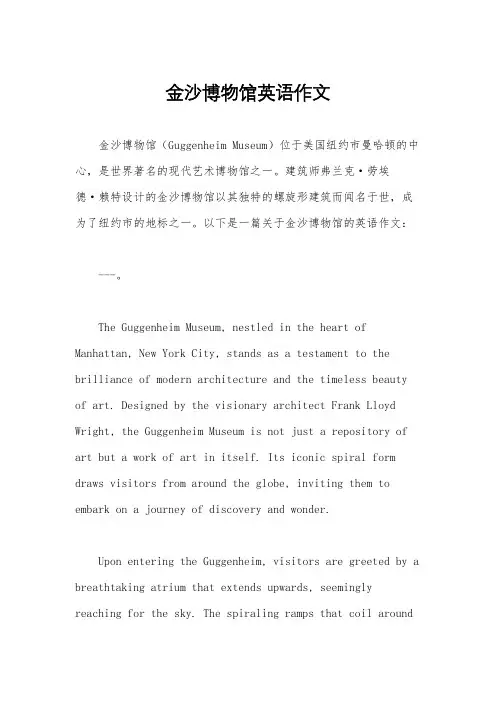
金沙博物馆英语作文金沙博物馆(Guggenheim Museum)位于美国纽约市曼哈顿的中心,是世界著名的现代艺术博物馆之一。
建筑师弗兰克·劳埃德·赖特设计的金沙博物馆以其独特的螺旋形建筑而闻名于世,成为了纽约市的地标之一。
以下是一篇关于金沙博物馆的英语作文:---。
The Guggenheim Museum, nestled in the heart of Manhattan, New York City, stands as a testament to the brilliance of modern architecture and the timeless beauty of art. Designed by the visionary architect Frank Lloyd Wright, the Guggenheim Museum is not just a repository of art but a work of art in itself. Its iconic spiral form draws visitors from around the globe, inviting them to embark on a journey of discovery and wonder.Upon entering the Guggenheim, visitors are greeted by a breathtaking atrium that extends upwards, seemingly reaching for the sky. The spiraling ramps that coil aroundthe atrium lead visitors on a continuous journey through the museum's galleries, creating a seamless flow of space that encourages exploration and contemplation. Each turn reveals a new perspective, a new artwork waiting to be discovered.The collection housed within the Guggenheim is as diverse as it is profound, spanning a wide range of styles and periods in the history of art. From the bold strokes of Picasso to the delicate intricacies of Japanese woodblock prints, the museum's collection offers something for every artistic palate. One can spend hours wandering the galleries, marveling at the creativity and ingenuity of the human spirit.Beyond its collection, the Guggenheim Museum is also a hub of artistic innovation and expression. It regularly hosts exhibitions and events that push the boundaries of contemporary art, showcasing the work of both established masters and emerging talents. From immersive installations to thought-provoking performance art, the museum is a vibrant center of cultural exchange and dialogue.But perhaps the most remarkable aspect of the Guggenheim is its ability to inspire. As visitors windtheir way through its spiraling corridors, they cannot help but feel a sense of awe and inspiration. Whether they are seasoned art aficionados or casual observers, the museumhas a way of touching the soul and igniting the imagination.In conclusion, the Guggenheim Museum is more than justa building or a collection of art. It is a testament to the power of human creativity and the enduring legacy ofartistic expression. With its iconic design andunparalleled collection, the Guggenheim continues to captivate and inspire generations of visitors, invitingthem to experience the transformative power of art in allits forms.。
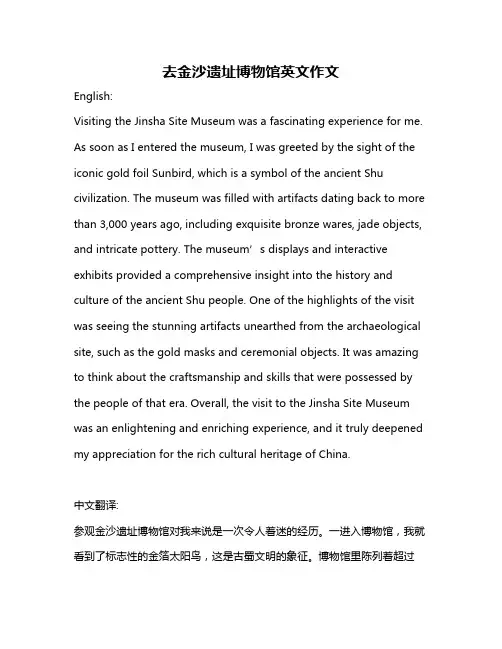
去金沙遗址博物馆英文作文English:Visiting the Jinsha Site Museum was a fascinating experience for me. As soon as I entered the museum, I was greeted by the sight of the iconic gold foil Sunbird, which is a symbol of the ancient Shu civilization. The museum was filled with artifacts dating back to more than 3,000 years ago, including exquisite bronze wares, jade objects, and intricate pottery. The museum’s displays and interactive exhibits provided a comprehensive insight into the history and culture of the ancient Shu people. One of the highlights of the visit was seeing the stunning artifacts unearthed from the archaeological site, such as the gold masks and ceremonial objects. It was amazing to think about the craftsmanship and skills that were possessed by the people of that era. Overall, the visit to the Jinsha Site Museum was an enlightening and enriching experience, and it truly deepened my appreciation for the rich cultural heritage of China.中文翻译:参观金沙遗址博物馆对我来说是一次令人着迷的经历。
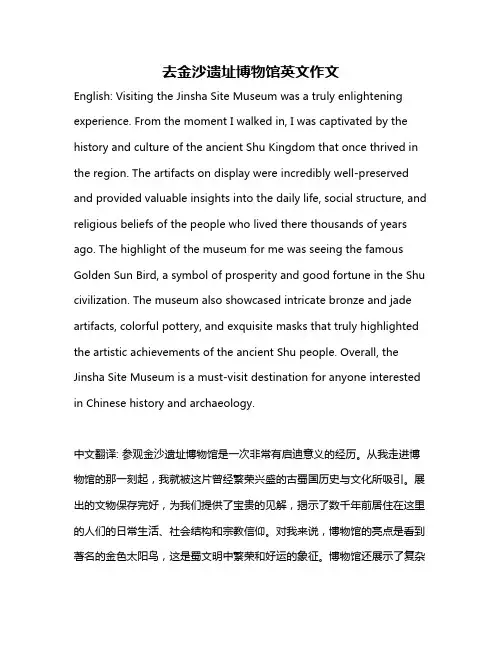
去金沙遗址博物馆英文作文English: Visiting the Jinsha Site Museum was a truly enlightening experience. From the moment I walked in, I was captivated by the history and culture of the ancient Shu Kingdom that once thrived in the region. The artifacts on display were incredibly well-preserved and provided valuable insights into the daily life, social structure, and religious beliefs of the people who lived there thousands of years ago. The highlight of the museum for me was seeing the famous Golden Sun Bird, a symbol of prosperity and good fortune in the Shu civilization. The museum also showcased intricate bronze and jade artifacts, colorful pottery, and exquisite masks that truly highlighted the artistic achievements of the ancient Shu people. Overall, the Jinsha Site Museum is a must-visit destination for anyone interested in Chinese history and archaeology.中文翻译: 参观金沙遗址博物馆是一次非常有启迪意义的经历。
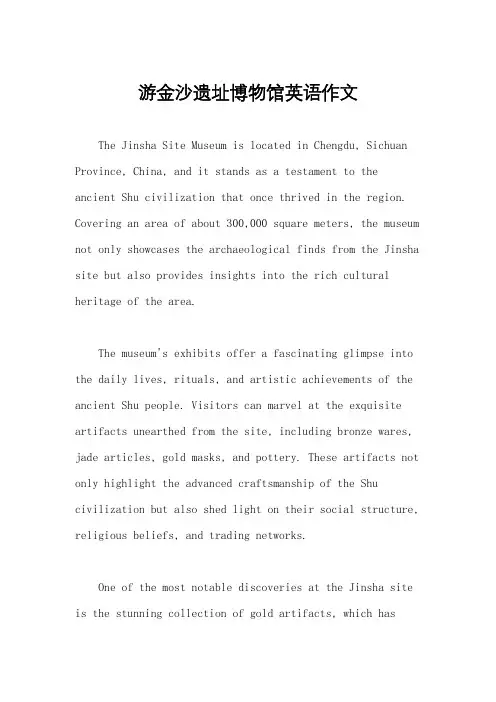
游金沙遗址博物馆英语作文The Jinsha Site Museum is located in Chengdu, Sichuan Province, China, and it stands as a testament to the ancient Shu civilization that once thrived in the region. Covering an area of about 300,000 square meters, the museum not only showcases the archaeological finds from the Jinsha site but also provides insights into the rich cultural heritage of the area.The museum's exhibits offer a fascinating glimpse into the daily lives, rituals, and artistic achievements of the ancient Shu people. Visitors can marvel at the exquisite artifacts unearthed from the site, including bronze wares, jade articles, gold masks, and pottery. These artifacts not only highlight the advanced craftsmanship of the Shu civilization but also shed light on their social structure, religious beliefs, and trading networks.One of the most notable discoveries at the Jinsha site is the stunning collection of gold artifacts, which hasearned it the nickname "the Kingdom of Gold." These artifacts, including intricately crafted gold masks, ornaments, and plaques, showcase the exceptional skills of ancient Shu artisans and their reverence for gold as a symbol of wealth and status.In addition to its impressive collection of artifacts, the museum also features multimedia displays, interactive exhibits, and educational programs that help visitors better understand the significance of the Jinsha site and its place in Chinese history. Through guided tours, lectures, and hands-on activities, visitors can delve deeper into topics such as archaeology, anthropology, and conservation.Moreover, the museum's architecture itself is a sight to behold, blending modern design with elements of traditional Sichuanese culture. The sprawling complex encompasses exhibition halls, research facilities, and landscaped gardens, providing a tranquil environment for visitors to explore and learn.Overall, a visit to the Jinsha Site Museum offers a unique opportunity to journey back in time and explore the mysteries of the ancient Shu civilization. Whether you're a history enthusiast, an art lover, or simply curious about the cultural heritage of China, the museum promises an enriching and unforgettable experience.。
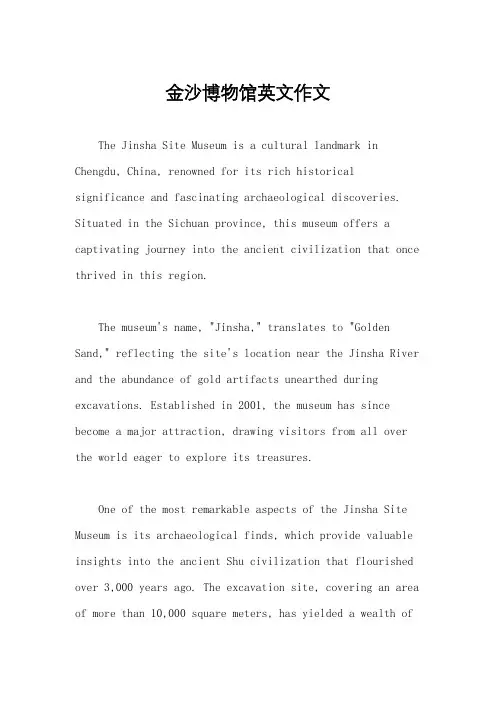
金沙博物馆英文作文The Jinsha Site Museum is a cultural landmark in Chengdu, China, renowned for its rich historical significance and fascinating archaeological discoveries. Situated in the Sichuan province, this museum offers a captivating journey into the ancient civilization that once thrived in this region.The museum's name, "Jinsha," translates to "Golden Sand," reflecting the site's location near the Jinsha River and the abundance of gold artifacts unearthed during excavations. Established in 2001, the museum has since become a major attraction, drawing visitors from all over the world eager to explore its treasures.One of the most remarkable aspects of the Jinsha Site Museum is its archaeological finds, which provide valuable insights into the ancient Shu civilization that flourished over 3,000 years ago. The excavation site, covering an area of more than 10,000 square meters, has yielded a wealth ofartifacts, including pottery, jade, bronze, and gold objects. These artifacts offer a glimpse into the daily life, customs, and beliefs of the ancient inhabitants of this region.One of the highlights of the museum is the "Sun Bird,"a symbol of the Jinsha culture and a masterpiece of ancient craftsmanship. This intricate gold ornament, depicting a mythical bird with outstretched wings, is adorned with exquisite detail and craftsmanship. It serves as a testament to the artistic achievements of the ancient Shu civilization and has become an iconic symbol of the museum.In addition to its archaeological treasures, the Jinsha Site Museum also offers visitors a chance to immerse themselves in the history and culture of ancient China through its exhibitions and educational programs. The museum's permanent exhibitions showcase a diverse range of artifacts, providing context and interpretation for the archaeological finds. Visitors can learn about the rituals, customs, and social structure of the ancient Shu civilization, gaining a deeper understanding of thisfascinating period in history.Moreover, the museum regularly hosts temporary exhibitions, featuring artifacts from other archaeological sites and cultural institutions. These exhibitions offer visitors the opportunity to explore different aspects of Chinese history and culture, further enriching their museum experience.Beyond its exhibitions, the Jinsha Site Museum also serves as a hub for research and education, with scholars and archaeologists from around the world conducting research and participating in academic exchange programs. Through its educational initiatives, the museum seeks to promote public awareness and appreciation of archaeology and cultural heritage, inspiring future generations to explore the wonders of the past.In conclusion, the Jinsha Site Museum stands as a testament to the rich cultural heritage of Chengdu and the surrounding region. With its fascinating archaeological finds, engaging exhibitions, and educational programs, itoffers visitors a unique opportunity to journey back in time and uncover the mysteries of the ancient Shu civilization. Whether you're a history enthusiast, a cultural explorer, or simply curious about the past, a visit to the Jinsha Site Museum is sure to be a memorable and enriching experience.。
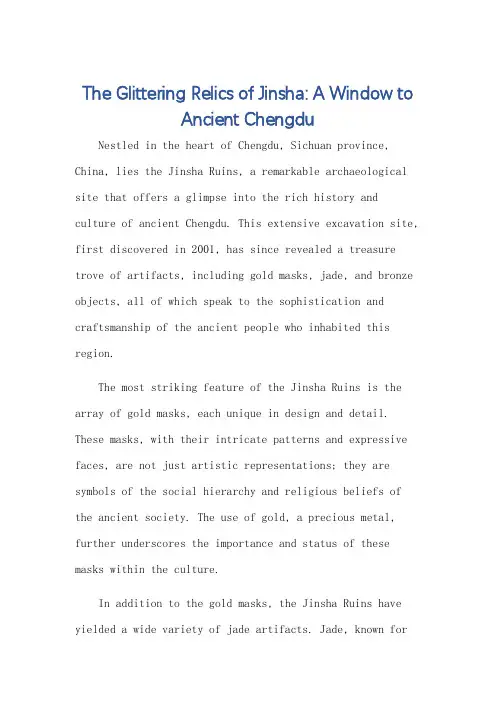
The Glittering Relics of Jinsha: A Window toAncient ChengduNestled in the heart of Chengdu, Sichuan province, China, lies the Jinsha Ruins, a remarkable archaeological site that offers a glimpse into the rich history andculture of ancient Chengdu. This extensive excavation site, first discovered in 2001, has since revealed a treasure trove of artifacts, including gold masks, jade, and bronze objects, all of which speak to the sophistication and craftsmanship of the ancient people who inhabited this region.The most striking feature of the Jinsha Ruins is the array of gold masks, each unique in design and detail. These masks, with their intricate patterns and expressive faces, are not just artistic representations; they are symbols of the social hierarchy and religious beliefs of the ancient society. The use of gold, a precious metal, further underscores the importance and status of these masks within the culture.In addition to the gold masks, the Jinsha Ruins have yielded a wide variety of jade artifacts. Jade, known forits beauty and durability, was highly valued in ancient times. The jade artifacts found at Jinsha exhibit a rangeof shapes and sizes, from small beads to larger decorative pieces, each meticulously crafted to perfection.Bronze objects are also abundant at the Jinsha Ruins. Bronze, a metal alloy primarily composed of copper, was widely used in ancient China for its durability andaesthetic appeal. The bronze artifacts discovered at Jinsha, including vessels, tools, and weapons, reflect the advanced metallurgy skills of the ancient Chengdu people.The excavation of the Jinsha Ruins has not onlyrevealed the material culture of the ancient Chengdusociety but has also provided insights into their spiritual life. Evidence of ritual practices and burial customs, such as the burial pits and offerings found at the site, offer a peek into the beliefs and values of the ancient people.The Jinsha Ruins are not just a collection of artifacts; they are a living testament to the rich history and vibrant culture of ancient Chengdu. This archaeological site, which continues to yield new discoveries, is a bridge between thepast and the present, connecting us to the ancestors who once called this land home.**金沙遗址:探寻古成都的璀璨珍宝**位于中国四川省成都市中心的金沙遗址,是一处令人瞩目的考古遗址,它为我们提供了窥探古成都丰富历史和文化的窗口。

金沙遗址的英文作文80词English:The Jinsha Site, located in Chengdu, China, is an important archaeological discovery dating back over 3,000 years. This site was unearthed in 2001 during construction work and has revealed a wealth of artifacts from the ancient Shu civilization. Among the discoveries are elaborate bronze objects, jade artifacts, ivory, and gold objects, providing valuable insights into the culture and society of that era. The most iconic find at Jinsha is the "Sun and Immortal Bird" gold foil, symbolizing the ancient Shu people's reverence forthe sun and their artistic achievements. The site's museum showcases these remarkable artifacts, offering visitors a glimpse into the rich history of the region and its early inhabitants.中文翻译:金沙遗址位于中国成都,是一处重要的考古发现,可以追溯到3000多年前。
这个遗址于2001年在建设工程中被发现,揭示了古蜀文明的丰富文物。
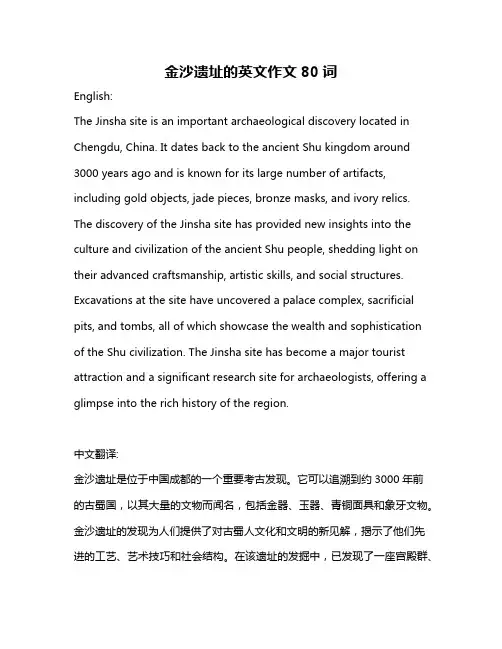
金沙遗址的英文作文80词English:The Jinsha site is an important archaeological discovery located in Chengdu, China. It dates back to the ancient Shu kingdom around 3000 years ago and is known for its large number of artifacts, including gold objects, jade pieces, bronze masks, and ivory relics. The discovery of the Jinsha site has provided new insights into the culture and civilization of the ancient Shu people, shedding light on their advanced craftsmanship, artistic skills, and social structures. Excavations at the site have uncovered a palace complex, sacrificial pits, and tombs, all of which showcase the wealth and sophistication of the Shu civilization. The Jinsha site has become a major tourist attraction and a significant research site for archaeologists, offering a glimpse into the rich history of the region.中文翻译:金沙遗址是位于中国成都的一个重要考古发现。
金沙遗址英语作文素材(中英文实用版)**English Composition: Jinsha Site**The Jinsha Site, an archaeological treasure trove, is a testament to the rich history and cultural heritage of China.Located in the suburbs of Chengdu, Sichuan Province, this site has yielded a vast array of relics that provide valuable insights into the ancient Shu civilization.Discovered in 2001, the Jinsha Site has excavated thousands of artifacts, including jade and stone carvings, gold and bronze objects, and even elephant tusks.Among the most captivating finds are the life-sized human figurines and the intricate gold masks, which demonstrate the exquisite craftsmanship of the time.The site dates back to approximately 1,600 to 1,200 years ago, corresponding to the later stage of the Shu Kingdom.It is believed to be a significant center of trade and politics, indicating the prosperity and sophisticated culture of the region during the Bronze Age.The Jinsha Site not only enriches our understanding of ancient Chinese history but also highlights the importance of cultural preservation.It stands as a reminder of the indomitable spirit of human civilization and the continuous pursuit of knowledge.**金沙遗址作文**金沙遗址,一处考古学的宝库,见证了我国深厚的历史文化底蕴。
英语介绍金沙遗址作文The Jinsha Site is an archaeological site located in the western part of Chengdu, Sichuan Province, China. It was discovered in 2001 during construction work and has since become one of the most important archaeological finds in China. The site covers an area of 5 square kilometers and is estimated to have been inhabited by the Sanxingdui culture from around 1200 BC to 650 BC.The Jinsha Site is famous for its large collection of artifacts, including bronze, gold, jade, and ivory objects. These artifacts provide valuable insights into the culture, religion, and daily life of the Sanxingdui people. One of the most impressive finds is a gold foil mask, which is believed to have been used in religious ceremonies. The mask is 14 centimeters tall and weighs around 200 grams. It is decorated with intricate patterns and has two holes for the eyes.Other notable artifacts include bronze statues ofanimals, such as elephants, snakes, and birds. These statues are highly detailed and show a high level of skill in metalworking. There are also jade objects, such as pendants and beads, which were likely used for decoration or as symbols of status.In addition to the artifacts, the Jinsha Site also contains the remains of a palace complex, which is believed to have been the center of political and religious power in the Sanxingdui culture. The complex includes a largecentral building, surrounded by smaller buildings and courtyards. The walls of the buildings are decorated with colorful murals, which depict scenes from daily life, as well as religious and mythological themes.The discovery of the Jinsha Site has had a significant impact on our understanding of ancient Chinese culture. It has challenged the traditional view that Chinesecivilization developed only in the Yellow River basin and has shown that there were other advanced cultures in different parts of China. The site has also provided evidence of a highly developed and sophisticated society,with advanced metalworking techniques, complex religious beliefs, and a rich artistic tradition.Today, the Jinsha Site is open to the public and has become a popular tourist attraction. Visitors can see the artifacts on display in the museum, as well as the remains of the palace complex. The site is a must-see for anyone interested in ancient Chinese history and culture.。
The Jinsha Site: A Glimpse into Ancient ChengduNestled in the heart of Chengdu, Sichuan Province, lies the Jinsha Site, a precious archaeological treasure trove that offers a unique window into the ancient history and culture of the region. This remarkable site, discovered in 2001, dates back over 3000 years, revealing a vibrant civilization that flourished along the banks of the Jinjiang River.The Jinsha Site is renowned for its extensive excavations that have uncovered a wealth of artifacts, including bronze wares, jade ornaments, pottery, and stone implements. These relics provide invaluable insights into the lifestyle, craftsmanship, and beliefs of the ancient Shu culture. The site is also famous for its burial grounds, which feature elaborate tombs decorated with intricate patterns and symbols, reflecting the sophisticated burial practices of the time.One of the most remarkable discoveries at the Jinsha Site is the large number of ivory artifacts, including ivory rods and plaques, which are believed to have been used for ritual purposes. These ivory objects, along with other relics, suggest that the Jinsha culture was deeply rooted in religious and spiritual beliefs.Moreover, the Jinsha Site offers a fascinating glimpse into the development of urban civilization in ancient China. The excavated remains of buildings, roads, and drainage systems indicate a well-organized and sophisticated urban settlement. This urban landscape provides important clues about the social, economic, and political structure of the ancient Shu Kingdom.In conclusion, the Jinsha Site is a testament to the rich history and vibrant culture of ancient Chengdu. Its excavations have not only revealed the splendor of the past but also offered insights into the evolution of human civilization. This site continues to attract scholars, archaeologists, and tourists alike, who come to marvel at its treasures and appreciate the enduring legacy of the ancient Shu culture.。
在金沙博物馆作文英语The Jinsha Site Museum is located in Chengdu, Sichuan Province, China. It is a world-renowned museum that showcases the ancient civilization of the Shu Kingdom. The museum is built on the site where the Jinsha archaeological discoveries were made, and it has become a popular tourist destination for people from all over the world.The museum is home to a vast collection of artifactsthat date back to the Shang and Zhou dynasties, and it provides visitors with a unique insight into the historyand culture of the ancient Shu Kingdom. The artifacts on display include bronze wares, jade objects, gold masks, and other precious items that were unearthed at the Jinsha Site. These artifacts are not only historically significant, but they also showcase the advanced craftsmanship and artistic skills of the ancient Shu people.One of the most famous exhibits at the museum is the Gold Sunbird, which is a symbol of the Jinsha culture. TheGold Sunbird is a large, gold-plated bronze artifact that was discovered at the site, and it is a testament to the advanced metalworking techniques of the Shu people. The artifact is intricately designed and is believed to have been used for ceremonial purposes, making it a truly remarkable piece of ancient art.In addition to the artifacts, the museum also featuresa number of interactive exhibits and multimedia presentations that provide visitors with a deeper understanding of the history and culture of the Shu Kingdom. These exhibits include virtual reality experiences, interactive displays, and multimedia presentations thatbring the ancient civilization to life in a way that isboth educational and entertaining.The museum also offers guided tours and educational programs for visitors of all ages, making it an ideal destination for families, school groups, and history enthusiasts. The museum's knowledgeable staff arepassionate about sharing the history and culture of the Shu Kingdom, and they are dedicated to providing visitors withan informative and engaging experience.In conclusion, the Jinsha Site Museum is a must-visit destination for anyone interested in ancient history and culture. The museum's vast collection of artifacts, interactive exhibits, and educational programs provide visitors with a unique insight into the ancientcivilization of the Shu Kingdom. Whether you are a history enthusiast, a student, or a curious traveler, the Jinsha Site Museum is sure to leave a lasting impression and provide you with a deeper appreciation for the rich cultural heritage of China.。
金沙遗址简介英文作文英文:Jinsha Site is an important archaeological site in China, located in Chengdu, Sichuan Province. It was discovered in 2001 during the construction of a new building. Since then, many valuable cultural relics have been unearthed, including gold, jade, bronze, and ivory artifacts, as well as a large number of pottery and stoneware items.The site dates back to the Shang and Zhou dynasties, over 3,000 years ago. It was an important center of the ancient Shu Kingdom, and its discovery has greatly enriched our understanding of the region's history and culture. The most famous discovery at the site is the Golden Sun Bird, a small gold sculpture that is considered a masterpiece of ancient Chinese art.I visited Jinsha Site last year and was amazed by therich history and culture that it represents. The museum on the site is well-designed and informative, with manyexhibits showcasing the various artifacts that have been discovered. I particularly enjoyed seeing the Golden SunBird up close, as well as the intricate bronze masks andthe colorful pottery.中文:金沙遗址是中国四川成都的一个重要考古遗址。
金沙博物馆英文介绍作文The Jinsha Site Museum, located in Chengdu, China, stands as a testament to the rich and ancient history of the Shu civilization. Unearthed in 2001, the Jinsha site unveiled a treasure trove of artifacts that revolutionized our understanding of this enigmatic culture. The museum, established in 2006, serves as a sanctuary for these invaluable relics, providing visitors with a captivating glimpse into a bygone era. Upon entering the museum, one is greeted by an architectural masterpiece that seamlessly blends modern aesthetics withtraditional Chinese design elements. The spacious exhibition halls are bathed in natural light, creating an ambiance of reverence and awe. The exhibits are meticulously curated, guiding visitors on a chronological journey through the rise and fall of the Jinsha civilization. The most striking feature of the museum is undoubtedly the sheer volume and diversity of artifacts on display. From intricate gold ornaments and jade carvings to bronze vessels and ivory artifacts, each piece offers a window into the artistic prowess and cultural sophistication of the Jinsha people. A highlight of the collection is the iconic gold mask, a symbol of power and authority that has become synonymous with the Jinsha civilization. Its intricate design and masterful craftsmanship leave an indelible impression on all who behold it. Beyond the dazzling artifacts, the museum also sheds light on the daily lives of the Jinsha people. Excavated remains of houses, workshops, and burial sites provide valuable insights into their social structure, religious beliefs, and agricultural practices. The abundance of pottery shards, tools, and animal bones paints a vivid picture of a thriving community that flourished along the banks of the Minjiang River over 3,000 years ago. The Jinsha Site Museum goes beyond mere exhibition; it actively engages in archaeological research and conservation efforts. A dedicated team of experts meticulously studies the artifacts, employing cutting-edge technology to unravel the mysteries of the past. The museum also collaborates with international institutions to share knowledge and promote cross-cultural understanding. In conclusion, the Jinsha Site Museum is a cultural gem that offers a fascinating journey through time. Its stunning collection of artifacts, immersive exhibits, and ongoing research initiatives make it a must-visit destination for anyone interested in Chinese history andarchaeology. As a testament to the enduring legacy of the Shu civilization, the museum stands as a reminder of the rich tapestry of human history and the importance of preserving our cultural heritage for generations to come.。
金沙遗址博物馆英文介绍
The JinSha Archaeology Museum is located in Chengdu City, Sichuan Province. It was built on the site of the ancient city of JinSha, which was discovered by archaeologists in 2001 and is known as the "cradle of Chengdu civilization". The museum displays a large number of cultural relics unearthed from the archaeological site, including bronze ware, pottery, jade, bone tools, and other artifacts.
The museum covers an area of more than 8,000 square meters. It has two exhibition halls and one special exhibition hall. In the first hall,
visitors can learn about the history of JinSha through the introduction of pictures, text and multimedia technology. In the second hall, visitors can appreciate the unearthed cultural relics, including bronze ware, jade, porcelain, stone carvings, lacquerware, and bamboo slips. Visitors can also watch a 3D movie to get a better understanding of the ancient JinSha culture. In the
special exhibition hall, visitors can enjoy various activities related to the ancient JinSha culture.
The JinSha Archaeology Museum is a great place for visitors to explore the history of Chengdu and understand the culture of ancient China.。